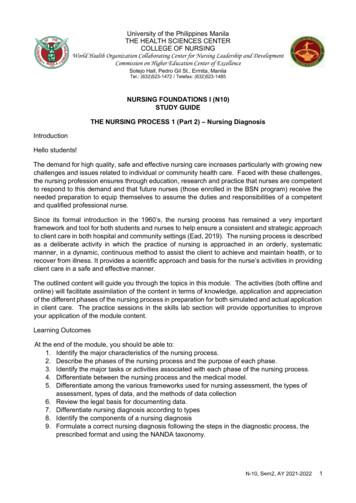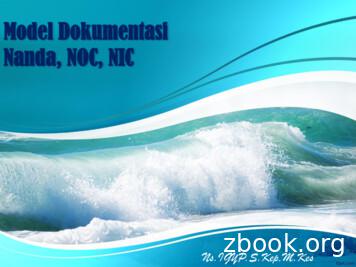NANDA Nursing Diagnosis
NANDA NURSING DIAGNOSISLast updated August 2009, * new diagnosis 2009-2011 Nutrition: imbalanced, less than bodyPersonal identity, disturbedrequirementsPost trauma syndrome Nutrition: imbalanced, more than bodyPost trauma syndrome, risk forrequirementsPower, readiness for enhanced Nutrition: imbalanced, risk for morePowerlessnessthan body requirementsPowerlessness, risk for Nutrition, readiness for enhancedRape-trauma syndrome Oral mucous membrane, impairedRelocation stress syndrome Swallowing, impairedRelocation stress syndrome, risk for*Resilience, impaired individualGastro*Resilience, readiness for enhanced *Jaundice, neonatal*Resilience, risk for compromised Liver function, impaired, risk forSelf concept, readiness for enhanced NauseaSelf-esteem, chronic lowActivity/Rest-ability to engage innecessary/desired activities of life (work andleisure) and to obtain adequate sleep/rest Activity intolerance Activity intolerance, risk for Disuse syndrome, risk for Divisional activity, deficit Fatigue Insomnia Mobility: bed, impaired Mobility: physical, impaired Mobility: wheelchair, impaired Sedentary lifestyle Sleep deprivation *Sleep pattern disturbed Sleep, readiness for enhanced Transfer ability, impaired Walking, impaired Circulation- ability to transport oxygen andnutrients necessary to meet cellular needs *Bleeding, risk for Cardiac output, decreased *Tissue perfusion, decreased cardiactissue, risk for *Tissue perfusion, ineffective,cerebral, risk for *Tissue perfusion, ineffective, renal,risk for *Tissue perfusion, ineffectivegastrointestinal, risk for Tissue perfusion, ineffective,peripheral *Shock, risk forEndo Blood glucose, risk for unstableEgo Integrity- ability to develop and useskills and behaviors to integrate andmanage life experiences Anxiety Anxiety, death Body image, disturbed Coping, community, ineffective Coping, community, readiness forenhanced Coping, defensive Coping, family, compromised Coping, family, disabled Coping, family, readiness for enhanced Coping, (individual), readiness forenhanced Coping, ineffective Denial, ineffective Energy field disturbance Fear Grieving Grieving, complicated Grieving, risk for complicated Health behavior, risk prone Human dignity, risk for compromisedSelf-esteem, situational lowSelf-esteem, risk for situational lowSorrow, chronicStress, overloadElimination- ability to excrete wasteproducts Bowel incontinence Constipation Constipation, risk for Constipation, perceived Diarrhoea *Motility, dysfunctionalgastrointestinal *Motility, risk for dysfunctionalgastrointestinal Urinary elimination, readiness forenhanced Urinary elimination, impaired Urinary incontinence, functional Urinary incontinence, overflow Urinary incontinence, reflex Urinary incontinence, stress Urinary incontinence, urge Urinary incontinence, risk for urge Urinary retentionFood/fluid- ability to maintain intake of andutilize nutrients and liquids to meetphysiological needs Breastfeeding, effective Breastfeeding, ineffective Breastfeeding, interrupted *Electrolyte imbalance, risk for Failure to thrive, adult Fluid balance, readiness for enhanced Fluid volume, deficient Fluid volume, deficient risk for Fluid volume excess Fluid volume, imbalanced, risk for Infant feeding pattern, ineffectiveGrowth and development Dentition, impaired Development delayed, risk for Growth, disproportionate, risk for Growth and development, delayedHealth promotion/Education Health maintenance, ineffective Health management, self, ineffective Health-seeking behaviors (specify) Immunization status, readiness forenhanced Knowledge deficient (specify) Knowledge (specify), readiness forenhanced Therapeutic regime management:family ineffective Hygiene- ability to perform activities ofdaily living *Neglect, self Self care, readiness for enhanced Self-care deficit, feeding Self-care deficit, bathing Self-care deficit, dressing Self-care deficit, toiletingLife Principles *Activity planning, ineffective Decisional conflict Decision making, readiness forenhanced Moral distress Noncompliance (specify) Hope, readiness for enhanced Hopelessness Religiosity, impaired Religiosity, readiness for enhanced Religiosity, risk for impaired Spiritual distress Spiritual distress, risk of Spiritual well being, readiness forenhancedNeurosensory- ability to perceive, integrateand respond to internal and external cues Autonomic dysreflexia Autonomic dysreflexia, risk for Communication, impaired verbal Communication, readiness forenhanced Confusion, acute Confusion, acute, risk for Confusion, chronic Environmental interpretationsyndrome, impaired Infant behavior, disorganized Infant behavior, disorganized, risk for Infant behavior, organized, readinessfor enhanced Intracranial adaptive capacity,decreased Memory, impaired Neurovascular dysfunction, peripheralrisk for Sensory perception disturbed(specify):visual, auditory, kinesthetic,gustatory, tactile, olfactory Unilateral neglectPain/discomfort- ability to controlinternal/external environment to maintaincomfort *Comfort, impaired Comfort, readiness for enhanced Pain, acute Pain, chronic Perioperative positioning injury, riskforPoisoning, risk forProtection, ineffectiveSelf mutilationSelf mutilation, risk forSkin integrity, impairedSkin integrity, impaired, risk forSudden infant death syndrome, risk forSuffocation, risk forSuicide, risk forSurgical recovery, delayedThermoregulation, ineffectiveTissue integrity, impairedTrauma, risk for*Trauma, risk for vascularViolence, self-directed risk forViolence, other-directed, risk forWanderingSexuality (component of ego integrity andSocial interaction)- Ability to meetrequirements/characteristics of male/femalerole *Childbearing process, readiness forenhanced Sexual dysfunction Sexuality patterns, ineffectiveSocial Interaction- ability to establish andmaintain relationships Attachment, parent/infant/child, riskfor impaired Care giver role strainRespiration- ability to provide and use Care giver role strain, risk foroxygen to meet physiological needs Family processes, dysfunctional Airway clearance, ineffective Family processes, interrupted Aspiration, risk for Family processes, readiness for Breathing pattern, ineffectiveenhanced Gas exchange, impaired Loneliness, risk for Spontaneous ventilation, impaired Parenting, impaired Ventilatory weaning response, Parenting, readiness for enhanceddysfunctional (DVWR) Patenting, risk for impairedSafety- ability to provide safe, growth *Relationships, readiness for enhancedpromoting environment Role conflict, parental Body temperature, imbalanced, risk for Role performance, ineffective Contamination Social interaction, impaired Contamination, risk for Social isolation Falls, risk for Home maintenance, ineffective Hyperthermia Hypothermia Infection, risk for Injury, risk for *Maternal/fetal dyad, risk disturbed Latex allergy response Latex allergy response, risk for
Activity/RestActivity intolerance: insufficientphysiological or psychological energy toendure or complete required or desired dailyactivitiesActivity intolerance, risk for: at risk forexperiencing insufficient physiological orpsychological energy to endure or completerequired or desired daily activitiesWalking, impaired: limitation ofindependent movement within theenvironment on foot (or artificial limb)Circulation*Bleeding, risk for: at risk for a decrease inblood volume that may compromise healthCardiac output, decreased: inadequateblood pumped by the heart to meetmetabolic demands of the bodyDisuse syndrome, risk for: at risk fordeterioration of body systems as the result of *Tissue perfusion, decreased cardiactissue, risk for: risk for a decrease inprescribed or unavoidable musculoskeletalcardiac (coronary) circulationinactivityDiversional activity, deficient: decreasedstimulation from or interest or engagementin recreational or leisure activities*Tissue perfusion, ineffective, cerebral,risk for: risk for decrease cerebral tissuecirculationFatigue: an overwhelming, sustained senseof exhaustion and decreased capacity forphysical mental work at usual level*Tissue perfusion, ineffective, renal, riskfor: at risk for a decrease in bloodcirculation to the kidney that maycompromise healthInsomnia: a disruption in amount andquality of sleep that impairs functionMobility: bed, impaired: limitation ofindependent movement from one bedposition to anotherMobility: physical, impaired: limitation inindependent, purposeful physical movementfor the body or of one or more extremitiesMobility: wheelchair, impaired: limitationof independent operation of wheelchairwithin the environmentSedentary lifestyle: reports a habit of lifethat is characterized by a low physicalactivity levelSleep deprivation: prolonged periodswithout sleep (sustained natural, periodicsuspension of relative unconscious)*Sleep pattern disturbed: time-limitedinterruptions of sleep amount and qualitydue to external factorsSleep, readiness for enhanced: a pattern ofnatural, periodic suspension ofconsciousness that provides adequate rest,sustains a desired lifestyle, and can bestrengthenedTransfer ability, impaired: limitation ofindependence movement between twonearby surfaces*Tissue perfusion, ineffective,gastrointestinal, risk for: at risk fordecrease I gastrointestinal circulationTissue perfusion, ineffective, peripheral:decrease in blood circulation to theperipheries that may compromise health*Shock, risk for: at risk fro an inadequateblood flow to the body’s tissues which maylead to life-threatening cellular dysfunctionEgo IntegrityAnxiety: vague, uneasy feeling ofdiscomfort or dread accompanied by anautonomic response, with the source oftennonspecific or unknown to the individual; afeeling of apprehension caused byanticipation of danger. It is an alerting signalthat warns of impending danger and enablesthe individual to take measures to deal withthreat.Anxiety, death: vague uneasy feeling ofdiscomfort or dread generated byperceptions of a real or imagined threat toone’s existenceBody image, disturbed: confusion inmental picture of one’s physical selfCoping, community, ineffective: pattern ofcommunity activities (for adaptation andproblem solving) that is unsatisfactory formeeting the demands or needs of thecommunityCoping, community, readiness forenhanced: pattern of community activitiesfor adaptation and problem solving that isunsatisfactory for meeting the demands orneeds of the community but that can also beimproved for management or current andfuture problems/stressorsGrieving: a normal complex process thatincludes emotional, physical, spiritual,social and intellectual responses andbehaviors by which individuals, families andcommunities incorporate an actual,anticipated or perceived loss into their dailylivesCoping, defensive: repeated projection offalsely positive self-evaluations based onself-protective pattern that defends againstperceived threats to positive self regardGrieving, complicated: a disorder thatoccurs after the death of a significant other,in which the experience of distressaccompanying bereavement fails to follownormative expectations and manifest infunctional impairmentCoping, family, compromised: usuallysupportive primary person (family memberor close friend) provides insufficient,ineffective, or compromised support,comfort, assistance, or encouragement thatmay be needed to manage or masteradaptive tasks related to heath challengeCoping, family, disabled: behavior ofsignificant person (family member or otherprimary person) that disables his or hercapacity to effectively address tasksessential to either person’s adaptation tohealth challengesCoping, family, readiness for enhanced:effective management of adaptive tasks byfamily member involved with client’s healthchallenge, who now exhibits desire andreadiness for enhanced health and growthwith regard to self in relation to clientCoping, (individual), readiness forenhanced: pattern of cognitive andbehavioral efforts to manage demands that issufficient for wellbeing and can bestrengthenedCoping, ineffective: inability to form avalid appraisal of internal or externalstressors, inadequate choices of practicalresponses, and/or to access or use availableresourcesDenial, ineffective: conscious orunconscious attempt to disavow anxiety theknowledge or meaning of an event, toreduce anxiety/fear, but leading to thedetriment of healthEnergy field disturbed: a disruption of theflow of energy surrounding a person’sbeing, which results in a disharmony ofmind and spiritFear: response to perceived threat that isconsciously recognized as a dangerGrieving, risk for complicated: a t risk fora disorder that occurs after the death of asignificant other, in which the experience ofdistress accompanying bereavement fails tofollow normative expectations and manifestin functional impairmentHealth behavior, risk prone: impairedability to modify lifestyle/behaviors in amanner consistent with a change in healthstatusRelocation stress syndrome: physiologicaland/or psychological disturbances that resultfrom transfer from one environment toanotherRelocation stress syndrome, risk for: atrisk for physiological and/or psychologicaldisturbances that result from transfer fromone environment to another*Resilience, impaired individual:decreased ability to sustain a pattern ofpositive responses to an adverse situation orcrisis*Resilience, readiness for enhanced: apattern of positive responses to an adversesituation or crisis that can be strengthened tooptimize human potential*Resilience, risk for compromised: at riskfor decreased ability to sustain a pattern ofpositive responses to an adverse situation orcrisisHuman dignity, risk for compromised: atrisk for perceived loss of respect and honorSelf-concept readiness for enhanced: apattern of perceptions or ideas about the selfthat is sufficient for well-being and can bestrengthenedPersonal identity, disturbed: inability tomaintain an integrated and completeperception of selfSelf-esteem, chronic low:
NANDA NURSING DIAGNOSIS Last updated August 2009, * new diagnosis 2009-2011. Activity/Rest-ability to engage in necessary/desired activities of life (work and leisure) and to obtain adequate sleep/rest . *Maternal/fetal dyad, risk disturbed .
Definition and purpose of nursing diagnosis (NANDA-I) North American Nursing Diagnosis Association Taxonomy (NANDA -I) organizing principles. The purpose of the NANDA International organization is to define, refine, and promote a taxonomy of nursing diagnostic terminology (Herdman, Kamitsuru, & North American Nursing Diagnosis Association, 2018).
with NANDA International were identifi ed, and nurs-ing diagnoses were determined using the diagnostic algorithm of NANDA. In the current nursing diagno-ses, defi ning characteristics and related factors were identifi ed based on the nursing diagnosis of NANDA International 2009-2011. In the case of possible nursing diagnoses, risk fac-
A nursing diagnosis is defined by NANDA International (2013) as a clinical judgment concerning a human . Risk for disturbed maternal-fetal dyad NANDA Nursing Diagnosis Domain 9. Coping/stress tolerance Class 1. Post-trauma responses Risk for complicated immigration transition
North American Nursing Diagnosis Association (NANDA) NANDA didirikan sebagai badan formal untuk meningkatkan, mengkaji kembali dengan mengesahkan daftar terbaru dari diagnosis keperawatan yang digunakan oleh perawat praktisi. NANDA mengidentifikasi masalah atau k
However, the nursing diagnosis DTPs is of special clinical relevance in the context of mental health care, since it has been proved to be one of the most frequently used nursing diagnosis within this field (Escalada Hernández, Muñoz Hermoso, & Marro Larrañaga, 2013). The exclusion of this nursing diagnosis from the NANDA-I taxonomy makes
NANDA-APPROVED NURSING DIAGNOSES 2018-2020 Grand Total: 244 Diagnoses August 2017 Indicates new diagnosis for 2018-2020--17 total Indicates revised diagnosis for 2018-2020--72 total
NANDA (nursing diagnoses), NIC (interventions), and NOC (outcomes). NANDA has 167 diagnosis labels with definitions, defining characteristics, and related or risk factors used to define a client need or problem. NIC is a comprehensive standardized language providing 514 direct and indirect interven-
Classical approach to management is a set of homogeneous ideas on the management of organizations that evolved in the late 19 th century and early 20 century. This perspective emerges from the industrial revolution and centers on theories of efficiency. As at the end of the 19th century, when factory production became pervasive and large scale organizations raised, people have been looking for .























